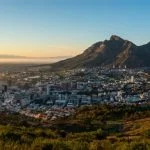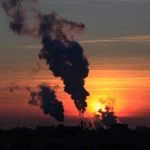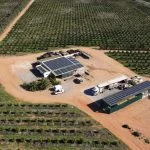As early as 1882, the South African city of Kimberly made history by being the first to install electric street lighting throughout the Southern Hemisphere. Worldwide, only the American city of Philadelphia was able to achieve it before them. It was a first step towards South Africa’s rich history with electricity. But the relationship between the population and their electricity supply is under great strain.
A brief sketch of the situation at the moment: In the country, the state-owned company Eskom regulates 90% of the electricity supply. On their website you can find their mission: “To provide sustainable electricity solutions, to grow the economy, and to improve the quality of life for the people in South Africa and in the region“. Sounds good, right? Unfortunately, it’s not so utopian in practice.
A collapsing fossil fuel dinosaur
Eskom is on the brink. The international press has known for years: “Eskom is a dinosaur waiting for the impact of a giant meteor“. The company went through several corruption scandals, which resulted in a total of several billion Rand being embezzled. As a result, there was a surplus of more than 30,000 employees, and the increasing distress caused by these scandals caused most of the highly skilled employees to walk. But the decision to start the construction of two huge new coal-fired power plants in 2007 raised the most questions. The construction of these two power stations, Kusile and Medupi (both 4.8 GW) was plagued by technical problems and are still not fully operational in 2020.
This year-long accumulation of poor decision-making and corruption caused Eskom to bury themselves in 30 billion Euros of debt. The consequences of this are visible. Eskom is unable to meet the demand for electricity, which means that the population has to deal with ‘load shedding‘: planned times when certain areas will be completely disconnected from the electricity grid. Households light an old-fashioned candle and companies start their pollutant diesel generators to keep the business running. The price of electricity has also risen enormously since 2007 (and will continue to rise much faster in the coming years).

Eskom’s electricity price has risen dramatically in the last few years (Source: mybroadband.co.za)
Heavy impact from climate change
Load shedding and a rising electricity price, no matter how great the impact, are not the most problematic long-term consequences of the policy. The impact on the environment, climate and livability in the country is tremendous. South Africa is the most polluting country on the entire continent and is ranked 14th in the list of world’s biggest polluters.
All this while the country is at the front line of the fight against climate change. South Africa heats up twice as fast as the global average, causing dry seasons to lengthen while the wet season shrinks, bombarding the nation with intense rainfall. While a country like the Netherlands is well prepared for heavy rainfall, South Africa is not. Because of this inexperience, relatively short periods of heavy rainfall cause large-scale flooding.
On the other hand, drought causes large-scale water shortages, especially in the bigger cities. Cape Town was in a major water crisis at the beginning of 2018 and was heading for ‘Day Zero‘: the day on which the water supply to households and businesses would be cut off. The four million inhabitants would then have to collect drinking water from central points. Fortunately, Day Zero was avoided, partly by encouraging residents to flush their toilets less and to fine heavy users.
Awareness of the climate crisis
So much for the situation in South Africa. Enough challenges to overcome, but change is on the horizon. And everyone is reaping the benefits. One of the solutions, solar energy, is a knife that cuts both ways. Households and companies with solar panels and storage capacity are in fact much less dependent on Eskom’s power supply. In this way, they save on energy costs and have a consistent energy supply. And because residents and companies generate their own sustainable energy, the polluting coal-fired power stations simply scale down their energy production.
An additional effect is that water is also saved. For every kWh generated with coal, 0.1 liters of water are needed. In the case of South Africa, that equates to roughly the amount of 30,000 Olympic swimming pools per year.
In order to bring about real, substantial change, it is important to create climate awareness. Because if you are not aware of a problem, you are not looking for a solution. Despite the massive impact climate change is having and will have on South Africa, only 41% of the population is familiar with the phenomenon. The media and politicians focus on day-to-day crises such as the job crisis and now Covid-19, diverting the viewers’ attention. Even if the crisis is closely linked to climate change, such as a water shortage or flooding, climate change is rarely part of the discussion.
“For every kWh generated with coal, 0.1 liters of water are needed. In the case of South Africa, that equates to roughly the amount of 30,000 Olympic swimming pools per year.”
But, like all other places in the world, climate activism is beginning to take hold in South Africa among the youngest part of the population. Meanwhile, politicians and investors are feeling the pressure of the population demanding change. Households and businesses are becoming increasingly aware of their own emissions and are therefore more inclined to switch to sustainable alternatives.
Jobs, jobs, jobs.
And then: action. After all, talk is cheap and great ideas don’t put solar panels on roofs. People do. South Africa has been in a jobs crisis for years, which has become even worse since the outbreak of Covid-19. More than 30% of the working population is unemployed, one of the highest unemployment rates in the world.
Recent research shows that the total number of jobs in the South African energy sector will increase by at least 17% by 2050 thanks to the energy transition. This includes all lost jobs in the coal industry. Across the economy as a whole, at least 1.6 million more jobs are indirectly linked to the energy transition.
It is important that the new jobs in sustainable energy are created in the places where jobs in the fossil industry are being lost. In this way, the burdens, but especially the fruits of the new economy, will be shared fairly.
Sustainable, affordable and reliable solar energy for everyone
There are few countries where solar energy has such enormous potential as South Africa. With over 2,500 hours of sunshine per year, it is one of the sunniest countries on earth. Furthermore, due to the abundance of raw materials, it can even keep the production of solar panels domestic, which further stimulates employment.
The number of installed Solar PV installations has grown in recent years. It is mainly companies that have taken the step to solar energy. However, compared to the Netherlands, the number of panels is still small. Estimates vary, but in comparison the Netherlands has 5 times as many roof installations than South Africa.
Companies and households often do not have the means to make a relatively large investment in solar panels and storage capacity. That is why it is important to tailor financing options to the situation of the consumer. Soly South Africa therefore offers local entrepreneurs, schools or farmers, for example, the opportunity to lease solar panels and batteries without any investment. This keeps their business running, even during periods of load shedding, and the impact of rising electricity prices is minimal.
So, a decentralized, sustainable energy supply in which South African businesses and households produce and utilize their own energy. By storing solar power in batteries, the pressure on the energy grid is taken away. This way load shedding and fossil fuel emissions will be a thing of the past. Even in South Africa.
The energy supply in South Africa is due for a drastic change. From polluting, unstable and expensive, to sustainable, safe and affordable. With solar energy and battery storage, households and companies are less dependent on the power from the coal-fired power stations of energy supplier Eskom. This energy transition will help South Africa reduce its CO2 emissions and will do wonders for employment in the country.





